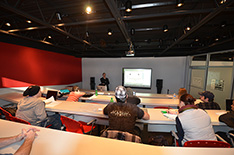

Carl Tatz Design's PhantomFocus™ System Goes to School
— Personal studio design guru Carl Tatz shares his design secrets and acclaimed PhantomFocus™ System expertise with students and staff at Berklee College of Music and SAE Nashville, as well as contributing a chapter to Bobby Owsinski's new tome The Studio Builder's Handbook —
Nashville, TN: "Carl Tatz has used his previous experience as a studio owner to become not only one of the most forward-looking studio designers today, but an innovator in monitoring technology as well. His PhantomFocus™ System (PFS) monitor tuning protocol is quickly becoming the standard by which all others are measured," quotes best selling author and music/technology advisor Bobby Owsinski, who has dedicated an entire chapter in his latest textbook, The Studio Builder's Handbook based on a point that Carl Tatz, noted personal studio designer and creator of the PFS , drives home with knowledgeable stealth and experience: "There is nothing more important in a control room than the accuracy of your monitoring."
Tatz also comments about his recent invitations to lecture at the prestigious Berklee College of Music in Boston, Massachusetts and the Nashville, Tennessee branch of SAE. "I try to give them something practical they can take with them and use right away in their own home studios." "Carl was so gracious to come speak with our senior audio students at SAE Nashville during Acoustics class. The students were very excited to hear about the PhantomFocusTM System and the information Carl shared provided an unparalleled educational experience for our students," comments Crystal Armentrout, Director of Education, SAE Nashville. Rob Jaczco, chairman of the Production and Engineering Department at Berklee, recalls "I thought the students asked some great questions and learned a lot also."
"There are quite a few things you can do to improve your home studio monitoring that are really quite simple and very rewarding if you are willing to take the initiative to calculate your monitoring position relative to the room's acoustic peaks and nulls and deal with the first reflection points relative to what I call the Null Positioning
EnsembleTM," instructed Tatz.
When Tatz extends this information to its logical end, adding many steps including various decoupling and isolation modules, subwoofer system and powerful DSP, the result is what he has achieved with the PhantomFocusTM System. "A lot of what I do is about myth-busting and I've broken quite a few in developing the PhantomFocusTM System, choosing to rely on physics and the resulting sonic performance rather than acoustic superstitions." And that performance is quite dramatic, as anyone who has experienced the PFS will agree.
About Carl Tatz Design
Carl Tatz Design (CTD) offers design and consulting services to homeowners and entertainment industry professionals in areas of: Recording Studios, Monitor Systems, Home Screening Rooms, Dedicated Listening Rooms, Acoustic Analysis, Tuning, and Sound Isolation. Carl Tatz is also the inventor of the industry acclaimed proprietary PhantomFocus™ System (PFS) monitor tuning protocol. CTD’s many resources combine knowledge, experience and expertise in sound, picture and design to serve its clients worldwide. For more information, visit http://www.carltatzdesign.com.
About the PhantomFocus™ System
Once the basic acoustic treatment has been accomplished, Carl Tatz Design’s proprietary PhantomFocus™ Monitor System offers clients a unique opportunity to have a truly world-class monitoring experience in their room, no matter how modest they may perceive it to be. The PhantomFocus System allows their monitors of choice to perform accurately at a full 20Hz-to-20KHz frequency response with pinpoint imaging in an almost holographic sweet spot — this enables their mixes to travel anywhere with a new level of sonic accuracy. There are approximately fifty steps in the proprietary PhantomFocus System implementation protocol, some of which may include phase and laser alignment, damping, isolation mounts, careful assessment of engineer/speaker placement relative to their room’s primary axial modes, proprietary speaker distance and angle, crossover points for pass filtering, and finally parametric equalization. Hardware can include monitor stands, concrete, sorbothane and other isolation materials, custom floating plenum mounts, subwoofer system, custom crossover, parametric equalizers and the monitors themselves (passive or active). The evaluation and implementation is a full two-day process and can be applied to near-fields, mid-fields, and large soffit mounted monitors, regardless of manufacturer. Carl Tatz Design can install the PhantomFocus System in existing control rooms or in studios that are designed and built from the ground up by CTD. The result is like the aural equivalent of HD TV. Once you experience a PhantomFocus System, you can’t go back.
Carl Tatz lectures students and staff at SAE Nashville about personal studio design and the PhantomFocus™ System
Carl Tatz lectures sudents and staff at Berklee College of Music in Boston about personal studio design and the PhantomFocus™ System
Bobby Owsinski's latest publication "The Studio Builder's Handbook" featuring the Carl Tatz Interview
Carl Tatz Design: 6666 Brookmont Terrace, Suite 1109, Nashville, TN 37205, 615.354.6242 / carl@carltatzdesign.com











